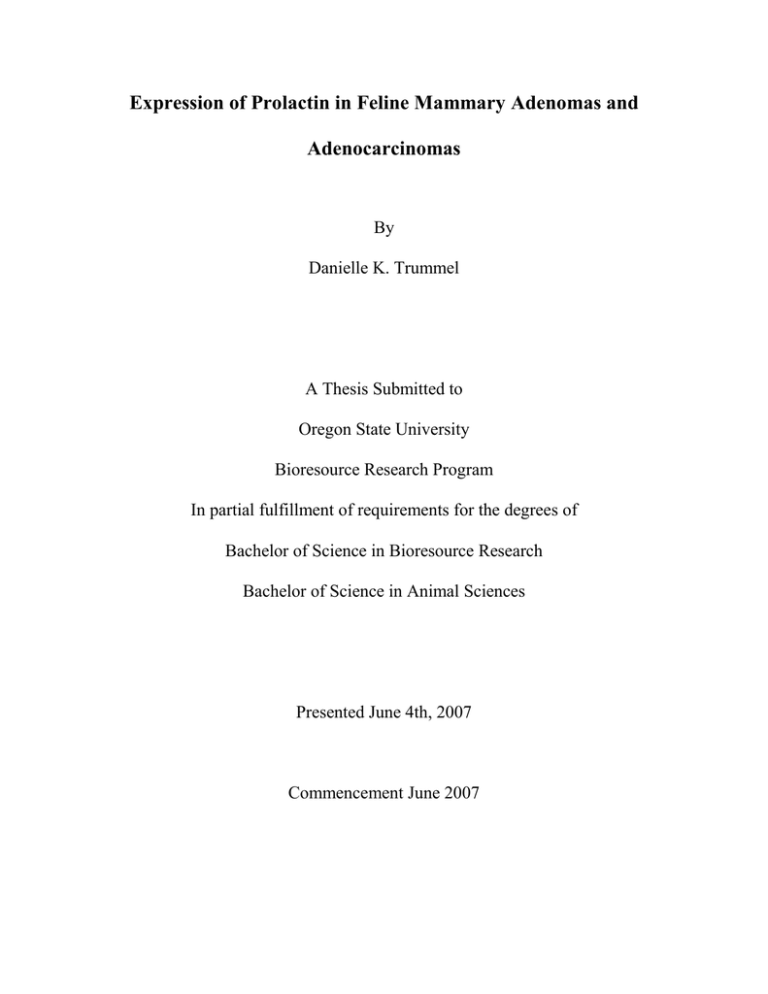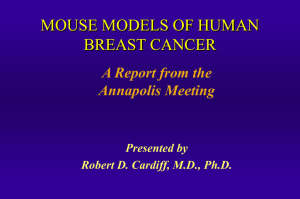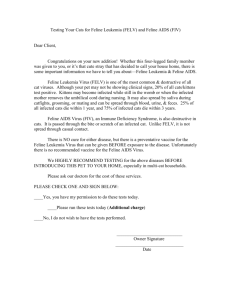
Expression of Prolactin in Feline Mammary Adenomas and
Adenocarcinomas
By
Danielle K. Trummel
A Thesis Submitted to
Oregon State University
Bioresource Research Program
In partial fulfillment of requirements for the degrees of
Bachelor of Science in Bioresource Research
Bachelor of Science in Animal Sciences
Presented June 4th, 2007
Commencement June 2007
An Abstract of the Thesis of
Danielle K. Trummel for the degree of Bachelor of Science in Bioresource Research with
an option in Animal Reproduction and Development and Bachelor of Science in Animal
Science with an option in Pre-Veterinary Medicine. Thesis presented on June 4th, 2007.
Title: Expression of Prolactin in Feline Mammary Adenomas and Adenocarcinomas
Mammary tumors are the third most common tumor in cats after cutaneous
neoplasia and lymphosarcoma. More than 80% of feline mammary tumors are
adenocarcinomas, which are similar to human mammary adenocarcinomas in their
biologic behavior and histologic characteristics. Despite treatment with radical
mastectomy, feline mammary adenocarcinoma is associated with a high incidence of
metastasis to regional lymph nodes, spleen, liver and lungs. Prolactin (PRL), a protein
hormone synthesized by the anterior pituitary gland, stimulates mammary epithelial cell
proliferation and differentiation. In many mammalian species, PRL is also produced
within the mammary gland. In humans and rodents, PRL is an important mitogen for
mammary neoplasia. However, the role of PRL has not been investigated in feline
mammary adenomas and adenocarcinomas. The purpose of this study was to determine
if feline mammary tumors expressed PRL. Formalin-fixed paraffin-embedded sections of
archived mammary tissues (n=6) previously submitted to the Oregon State University
Veterinary Diagnostic Laboratory were cut with a width of 6 microns and studied by a
modified indirect immunohistochemistry protocol with a polyclonal PRL antibody.
Feline anterior pituitary tissue was used to verify the validity of the procedure as PRL
2
expression by lactotrophs in the tissue had positive and specific staining. Prolactin
expression was positive and specific in glandular epithelial cells of the mammary gland
of some cats (2 of 4) with adenocarcinoma. In conclusion, these results suggest a
contribution of PRL in the development of feline mammary neoplasms. Further
exploration into the relationship between PRL and feline mammary adenocarcinomas is
needed.
© copyright by Danielle K. Trummel
June 4th, 2007
All rights reserved
Bachelor of Science in Bioresource Research thesis of Danielle Trummel presented on
June 4th, 2007
Approved:
________________________________________________________________________
Mentor: Dr. Michelle Kutzler
Date
________________________________________________________________________
Secondary Mentor: Dr. Stuart Helfand
Date
________________________________________________________________________
Tertiary Mentor: Dr. Christiane Lohr
Date
________________________________________________________________________
Bioresource Research Director: Dr Kate Field
Date
I understand that my thesis will become part of the permanent collection of Oregon State
University Libraries. My signature below authorizes release of my thesis to any reader
upon request.
________________________________________________________________________
Danielle K. Trummel
Date
Acknowledgements
I would like to express my sincere appreciation to Dr. Michelle Kutzler for being
an exceptional mentor. Her kindness, patience, and knowledge provided the best
environment for me to expand my passion for veterinary medicine. I also owe the
greatest appreciation for her assistance in the preparation of this manuscript.
I would also like to thank the members of my undergraduate committee; Dr.
Stuart Helfand, Dr. Christiane Lohr, and Dr. Kate Field for their assistance toward the
completion of my thesis. I also thank Kay Fisher from the College of Veterinary
Medicine’s Histopathology department for her knowledge and time regarding this
project.
I thank my parents, Eric and Danette Trummel, with all my heart for not only the
financial support, but their unconditional love and support in pursuing my passion to
become a veterinarian. Finally, I would like to thank my boyfriend, Matt Drennen, for
the company in the lab, supporting me in all that I do and always believing in me and my
dreams.
Table of Contents
Page
Introduction
1
Objective
4
Chapter I: Immunohistochemistry
Hypothesis
5
Materials and Methods
6
Attainment of Tissue Sections
6
Antibody Dilutions
6
Immunohistochemistry Protocol
7
Histologic Analysis
8
Results
11
Pituitary: Prolactin Positive
11
Adenocarcinomas: Prolactin Positive
12
Adenocarcinomas: Prolactin Negative
14
Adenomas: Prolactin Negative
16
Benign Hyperplastic Mammary Tissue: Prolactin Negative
18
Chapter II: Survivability
Hypothesis
20
Materials and Methods
21
Survey Preparation
21
Data Interpretation
21
Results
22
Discussion
24
Literature Cited
27
Appendices
Appendix 1: Solutions
30
Appendix 2: Antibodies
32
Appendix 3: Antigen Retrieval Techniques
33
Appendix 4: Sample Survivability Survey and Response
34
List of Figures
Page
Figure 1: Pituitary Tissue
11
Figure 2: Adenocarcinomas: Prolactin Positive
13
Figure 3: Adenocarcinomas: Prolactin Negative
15
Figure 4: Adenomas: Prolactin Negative
17
Figure 5: Benign Hyperplastic Mammary Tissue: Prolactin Negative
19
Figure 6: Kaplan-Meier Estimate
24
Figure 7: Patient Demographic
25
Figure 8: Outcomes
26
1
Introduction:
The cat has four pairs of mammary glands (cranial thoracic, caudal thoracic,
cranial inguinal and caudal inguinal) located in the subcutaneous fat layer of the ventral
body wall. Mammary tumors are the third most common tumor in cats after cutaneous
neoplasia and lymphosarcoma [21]. More than 80% of feline mammary tumors are
adenocarcinomas. Due to similarities in the biologic behavior and histologic
characteristics of human and feline mammary cancer [25], feline mammary
adenocarcinomas would be an appropriate model for the study of breast cancer in women.
One in nine women is diagnosed with breast cancer each year [23]. The feline model
would allow developments to be made in improving treatment options for both women
and cats.
Mammary neoplasia has been reported to occur in cats from 9 months to 23 years
of age [25]. The mean age of diagnosis is 10 to 12 years. Cats spayed at 6 months of age
had a 40-60% lower risk of developing mammary cancer compared to intact [25]. In
contrast to dogs, information pertaining to the success rate of spaying at the time of
diagnosis in cats is not known. However, research pertaining to mammary neoplasia in
rodent models and humans allows for a comparison to cats.
A guarded to poor prognosis is typically given with the diagnosis of feline
mammary adenocarcinoma due to its aggressiveness, invasiveness, and tendency to
metastasize. Tumor size is the most important factor determining prognosis. Larger
tumor size significantly decreases the median disease-free interval and survival time [25].
The benefit of surgery for feline mammary adenocarcinoma is limited due to early
metastases when tumor volumes are large. In one study, two-thirds of the cats that had
2
conservative surgery to remove only the affected mammary gland developed local
recurrence of the tumor [25]. Radical mastectomy (chain mastectomy or the removal of
all four mammary glands) is the treatment of choice [26]. Despite treatment by radical
mastectomy, feline mammary adenocarcinoma is associated with a high incidence of
metastasis to regional lymph nodes, spleen, liver and lungs [20]. In more than half of
cats with metastases, chemotherapy using doxorubicin alone or in combination with
cyclophosphamide has been shown to induce partial responses (>50% regression) [25].
All tumors should be histologically classified based on descriptive morphology as
stated by the World Health Organization in order to provide similarities and differences
between species and uniformity within a species. Mammary tumors are classified as
adenocarcinoma, sarcoma, carcinosarcoma and adenomas [10]. For the purposes of the
current study, only adenomas and adenocarcinomas will be discussed [10]. Adenomas
and adenocarcinomas are subclassified as simple or complex. A simple mammary tumor
is one that is composed of either secretory epithelial or myoepithelial cells [10]. A
complex mammary tumor is one that is composed of both secretory epithelial and
myoepithelial cells [10]. In the cat, the complex type of adenoma is extremely rare.
Prolactin (PRL) is a neuroendocrine protein hormone (23 kD) synthesized by
lactotrophs in the anterior pituitary gland (adenohypophysis). Prolactin is a necessary
hormone for the development of the mammary gland. Prolactin stimulates mammary
epithelial cell proliferation and differentiation and is essential for lactogenic activity at
parturition [11, 22]. In addition to the adenohypophysis, PRL is found in extra-pituitary
sites including the adrenal gland, bone, corpus luteum, lacrimal gland, lymphocytes,
pancreas, placenta, prostate, testes, and uterus [11, 22]. Prolactin enhances the immune
3
system and supports local angiogenesis [28]. In the testes, PRL induces expression of
luteinizing hormone receptors [28]. In dogs, humans and rodents, another extra-pituitary
source of PRL is the mammary gland [22]. The predominant source for PRL within the
mammary gland appears to be of epithelial origin with appreciably less observed in the
stroma and endothelium [23]. The role and regulation of PRL production within the
mammary gland may be related to the development of neoplasia.
Of the hormones secreted by the adenohypophysis, PRL is the only hormone that
does not stimulate secretion of another hormone, such as growth hormone (GH). The
adenohypophysis synthesizes and secretes GH in a similar manner as PRL. Structurally,
PRL is similar to GH [29]. Growth hormone is the primary hormone responsible for
regulating body growth and in intermediary metabolism [28]. Both normal and
neoplastic canine mammary tissues are extra-pituitary sources of GH [30]. However, it is
not known if the same is true in cats. There are many similarities between PRL and GH
and further study of the relationship between the two hormones is worth developing.
In humans and rodents, PRL is an important mitogen for mammary neoplasia. In
1959, Muhbock and Boot reported that PRL was important in the pathogenesis of
mammary tumors [11,32]. In dogs, Saluja and coworkers (1973) found that PRL was
higher in adenocarcinoma than in normal mammary tissue [26]. In 1995, Glusburg and
colleagues found PRL in normal and neoplastic mammary tissue women [3]. Prolactin
has been shown in the last decade to be a promising prognostic factor in human breast
cancer [22]. However, the role of PRL has not been investigated in feline mammary
neoplasia.
4
Objective:
To determine the immunoexpression of PRL in feline adenomas and adenocarcinomas
and correlate expression with established histopathological grading and survival
outcomes.
5
Chapter I: Immunohistochemistry
Hypothesis
Prolactin is expressed in feline mammary adenomas and adenocarcinomas.
6
Materials and Methods:
Attainment of Tissue Sections
Formalin-fixed tissue samples of feline mammary adenomas and
adenocarcinomas were collected from private veterinary hospitals within the state of
Oregon that had been sent to the Oregon State University Veterinary Diagnostic
Laboratory (OSUVDL) for histologic diagnosis. Tissue samples were paraffin-embedded
and embedded tissues were cut into 6 µm thick sections and prepared onto slides. Slides
were stained with hematoxylin and eosin (H&E) stain and interpreted by a pathologist.
The database of archived samples within the OSUVDL contained 71 feline mammary
tumor cases. The H&E slides from each of these cases were re-evaluated for the presence
of necrosis by Dr. Christiane Löhr, by a board-certified Veterinary Medical Anatomic
Pathologist within the OSUVDL. Necrosis is a common finding in tumors. During the
immunohistochemistry procedure, necrotic tissue will stain positively in a non-specific
manner. Therefore, samples with abundant necrotic tissue had to be excluded. Following
exclusion of these samples, 26 cases remained. A survey was prepared (see Chapter II)
and sent to the hospitals that had submitted samples. Survey responses were only
obtained from six cases: two adenomas and four adenocarcinomas. Although rare, one
case was represented by a male cat. In addition to the neoplastic mammary tissue
samples, tissue samples from two cases of feline benign mammary hyperplastia were
included as a non-neoplastic (normal) control. Adenohypophysis tissue samples from
two cats were also used as a positive control for the PRL antibody.
7
Immunohistochemistry
(See Appendix 1 for detailed list of solutions)
Mammary adenoma (n=2), adenocarcinoma (n=4), benign hyperplasia (n=2) and
adenohypophysis tissue sections were cut (6 µm thick) from paraffin blocks and mounted
on poly-L-lysine coated slides. Slides were deparaffinized in xylene and rehydrated in a
graded ethanol series (100%, 100%, 80%, 80%) to tap water and double distilled water
(ddH20). The action of tissue specific endogenous peroxidases (e.g. red blood cells) was
inhibited by incubating slides in a pre-treatment solution of 30% hydrogen peroxide in
automation buffer for 10 minutes at room temperature (20oC). When using a secondary
antibody containing horseradish peroxidase (HRP), it is essential to block endogenous
peroxidase activity to diminish non-specific staining. Slides were then blocked for 10
minutes at room temperature with a protein block. The protein block prevents
nonspecific binding of the primary antibody with tissue components other than its target
protein.
A cytokeratin primary antibody was applied at a ready-to-use dilution to one slide
of each of the mammary neoplasia tissue sections. Cytokeratins are a family of watersoluble proteins that form the cytoskeleton of epithelial cells. This antibody was used to
differentiate mammary epithelial cells from other mammary cell types, which allowed for
the classification of the tumor as simple or complex.
The optimal dilution for the PRL primary antibody was determined through
dilution testing. Dilutions were calculated by:
Antibody(µl)
Antibody(µl) + Antibody diluent (µl)
8
On separate slides, a PRL primary antibody was applied at three dilutions (1:250, 1:500,
1:1000) to each of the mammary neoplasia and adenohypophysis tissue sections for 1
hour at room temperature. The 1:250 dilution was determined to be ideal as it yielded the
least non-specific staining and the highest PRL intensity staining. The PRL primary
antibody was also applied to the benign hyperplasia mammary tissue at the 1:250
dilution. Specificity of PRL immunostaining was verified by replacement of the primary
antibody with a universal negative at a ready-to-use dilution.
Slides were washed with automation buffer six times and then reacted with a
secondary antibody (Envision HRP+ goat anti-rabbit) for 30 minutes at room
temperature. Slides were again washed with automation buffer six times. Nova Red®
was used as a chromagen and slides were counterstained with hematoxylin, followed by a
bluing agent (1% lithium carbonate). Hematoxylin stains the cell nucleus blue unless it
has already been stained by the Nova Red® chromagen. Slides were dehydrated and
coverslips were mounted. To coverslip the slides, a toluene-based liquid mounting
media was placed on the slide followed by a coverslip. A fine pointed needle was used to
diminish any air bubbles underneath the coverslip.
Histologic Analysis
A board-certified Veterinary Medical Anatomic Pathologist within the OSUVDL
re-examined all of the H&E stained slides to identify tumor characteristics and verify
histologic diagnoses. The same pathologist examined the immunostained slides.
Cytokeratin immunostained slides from the neoplastic tissues were classified as simple or
9
complex mammary tumors. Prolactin immunostained slides were evaluated for the
location and specificity of positive PRL staining.
10
Results:
1. Pituitary: Prolactin Positive
2. Adenocarcinomas: Prolactin Positive
3. Adenocarcinomas: Prolactin Negative
4. Adenomas: Prolactin Negative
5. Benign Hyperplastic Mammary Tissue: Prolactin Negative
11
1. Pituitary: Prolactin Positive
The lactotrophs within the feline adenohypophysis synthesize and secrete PRL.
In both feline pituitary samples, positive and specific PRL expression was observed
(Figure 1).
A
B
Figure 1. Positive PRL staining (arrows) within the feline adenohypophysis at a 1:250
dilution (A) and 1:1000 dilution (B) (40X magnification).
12
2. Adenocarcinomas: Prolactin Positive
In two cases of feline mammary adenocarcinoma, there was positive and specific
PRL immunostaining (Figure 2A and 2E). Prolactin was expressed in the glandular
epithelial cells and not within every tumor cell. Prolactin positive cells were present in
clusters, rather than individual cells. There was no immunostaining observed in the
negative controls (Figure 2B and 2F). Cytokeratin was localized to epithelial cells
(Figure 2C and 2G). Both of the PRL positive adenocarcinomas were classified as
simple adenocarcinomas based on the cytokeratin staining. One of these tumors was
histologically identified as a very aggressive tumor with lymph invasion (Figure 2D).
Figure 2. (Opposite page) Positive PRL staining (arrows) within the feline mammary
gland at a 1:250 dilution in two cats with adenocarcinoma (A, E). The specificity of
immunostaining was verified using a Universal negative antibody (B, F). Positive
cytokeratin staining within the feline mammary gland of the same two cats (C, G).
Serial sections stained with H&E were used to identify tumor type (D, H). All images
were digitally captured at 40X magnification.
13
Figure 2.
A
E
B
F
C
G
D
H
14
3. Adenocarcinomas: Prolactin Negative
In two cases of feline mammary adenocarcinoma, there was no positive PRL
immunostaining (Figure 3A and 3E). There was also no immunostaining observed in the
negative controls (Figure 3B and 3F). Cytokeratin was localized to epithelial cells
(Figure 3C and 3G). Both of the PRL negative adenocarcinomas were classified as
simple adenocarcinomas based on the cytokeratin staining.
Figure 3. (Opposite page) Negative PRL staining within the feline mammary gland at a
1:250 dilution in two cats with adenocarcinoma (A, E). The specificity of
immunostaining was verified using a Universal negative antibody (B, F). Positive
cytokeratin staining within the feline mammary gland of the same two cats (C, G).
Serial sections stained with H&E were used to identify tumor type (D, H). All images
were digitally captured at 40X magnification.
15
Figure 3.
A
E
B
F
C
G
D
H
16
4. Adenomas: Prolactin Negative
In two cases of feline mammary adenomas, there was no positive PRL
immunostaining (Figure 4A and 4E). There was also no immunostaining observed in the
negative controls (Figure 4B and 4F). Cytokeratin was localized to epithelial cells
(Figure 4C and 4G). One of the adenomas was simple (Figure 4C), while the other was
complex (Figure 4G). A complex mammary adenoma is a rare tumor in cats.
Figure 4. (Opposite page) Negative PRL staining within the feline mammary gland at a
1:250 dilution in two cats with adenoma (A, E). The specificity of immunostaining was
verified using a Universal negative antibody (B, F). Positive cytokeratin staining within
the feline mammary gland of the same two cats (C, G). One of the adenomas was simple
(C), while the other was complex (G). Serial sections stained with H&E were used to
identify tumor type (D, H). All images were digitally captured at 40X magnification.
17
Figure 4.
A
B
C
D
E
F
G
H
18
5. Benign Hyperplastic Mammary Tissue: Prolactin Negative
In two cases of benign feline mammary hyperplasia, there was no positive PRL
immunostaining (Figure 5A and 5D). Benign hyperplasia is a non-neoplastic tissue,
which demonstrates that PRL expression is specific to the neoplastic mammary tissues in
cats. There was also no immunostaining observed in the negative controls (Figure 5B
and 5E). Cytokeratin was localized to epithelial cells (Figure 5C and 5F). There was no
evidence of neoplastic processes using H&E staining (data not shown).
Figure 5. (Opposite page) Negative PRL staining within the feline mammary gland at a
1:250 dilution in two cats with benign hyperplasia (A, D). The specificity of
immunostaining was verified using a Universal negative antibody (B, E). Positive
cytokeratin staining within the feline mammary gland of the same two cats (C, F). All
images were digitally captured at 40X magnification.
19
Figure 5.
A
D
B
E
C
F
20
Chapter II: Survivability Rates
Hypothesis
Survival duration and tumor recurrence is positively correlated with prolactin expression.
21
Materials and Methods:
Survey Preparation
A survey was constructed to collect case history from each of the cats represented
in this study. Data on the quality of life, tumor recurrence, cause of death, and survival
duration post-diagnosis were obtained (Appendix 4). The survey was sent to veterinary
hospitals for 26 cases of feline mammary neoplasia. Survey responses were only obtained
from six cases: two adenomas and four adenocarcinomas.
Data Interpretation
An Oregon State University Statistical graduate student aided in the analysis
portion of this study after collecting case history. The survival duration post-diagnosis of
mammary neoplasia was analyzed. The date of tissue submission to OSUVDL was
considered the time of diagnosis. Kaplan-Meier (KM) estimates were used to determine
survival probabilities. The KM estimator used for this data set was:
where nj is the number of lives at risk (alive and uncensored) just before time tj , and
dj is the number of deaths at time tj. For studies with large sample sizes, the KaplanMeier estimate will approach the true survivability rate of the population.
22
Results:
Survivability Survey
The survivability rates in months post-diagnosis (time of biopsy) are graphically
represented in Figure 6. In the sample population of six cases, there was a survivability
rate of 30%. After eight months post-diagnosis, four of the cats had died. The two cases
that were still alive as of the time of the survey (September 2006) were both benign
adenomas. The data obtained in this study does not represent a simple random sample
from the population. Therefore, the combination of a non-response bias and a small
number of cases did not allow for the estimate to approach the true survivability rate.
23
Figure 6. Kaplan-Meier estimate of six cases of feline mammary neoplasia. Reference
lines have been added to the plots so that median survival times and 1-year survival times
can be estimated. The blue line indicates the survival rate at 1 year and the green line
indicates the median survival duration. The uncensored plus signs indicate two cases that
were still alive at the time the survey was collected (September 2006).
24
Discussion:
Although rare, a complex mammary adenoma was identified in a 12-year-old
castrated male cat. This tumor was negative for PRL expression. Both cases of feline
mammary adenomas were alive at the time of survey. This was expected as complete
excision of the benign tumor is typically not associated with recurrence.
In half (2 of 4) of the feline mammary adenocarcinomas, PRL was expressed in
glandular epithelial cells. The location of expression was similar to what has been
reported in human breast cancer [23]. It is of interest to note that the two cases of feline
mammary adenocarcinoma with PRL expression survived with longer than cases of feline
mammary adenocarcinoma without PRL expression. In contrast with our hypothesis,
survival duration post-diagnosis is negatively correlated with PRL expression.
According to this data, PRL may be a protective agent against feline mammary cancer.
Patient demographics and outcomes are shown in Figures 7 and 8, respectively.
Due to the small sample size, there can not be any inferences made to the population as a
whole. However, the data collected supports further study in the relationship between
PRL and feline mammary cancer.
25
Case #
VDL
Accession #
Sex
Age
Histologic
Diagnosis
1
05-10113-2
Castrate Male
12
Simple
Adenoma
2
05-1440-1
Spay
6
Complex
Adenoma
3
04-11453-1
Female
13
Simple
Adenocarcinoma
4
02-4378-1
Spay
14
Simple
Adenocarcinoma
5
02-4236-1
Spay
9
Simple
Adenocarcinoma
6
05-4566-2
Spay
13
Simple
Adenocarcinoma
Figure 7. Patient Demographic- Data collected from survivability survey conducted
from June to September 2006.
26
Adenomas
Adenocarincomas
Prolactin Positive
Prolactin Negative
Case #
1
2
3
4
5
6
Survival Duration
(months)
Still Alive
as of 9/06
Still Alive
as of 9/06
8
6
2
4
Tumor Reccurence
No
No
Yes
No
Yes
No
Figure 8. Outcomes- Data collected from survivability survey conducted from June to
September 2006. Six feline cases were represented.
27
References:
1. Benazzi C, et al. Basement Membrane Components in Mammary Tumours of the
Dog and Cat. J Comp Pathol 109: 214-252, 1993.
2. Benjamin SA, et al. Classification and behavior of canine mammary epithelial
neoplasms based on life-span observations in beagles. Vet Pathol 36: 423436, 1999.
3. Clevenger CV, et al. The Role of Prolactin in Mammary Carcinoma. Endocr Rev
24(1):1-27, 2003.
4. Clevenger CV, et al. Prolactin as an Autocrine/Paracrine Factor in Breast Tissue.
J of Mamm Gland Biol and Neopl 2(1):59-68, 2004.
5. Day MJ. Clinical Immunology of the Dog and Cat. Manson Publishing Ltd,
London, 1999.
6. El Etreby MF, et al. The role of the pituitary gland in spontaneous canine
mammary tumorigenesis. Vet Pathol 17:2-16, 1980.
7. Emerman JT, et al. Elevated growth hormone levels in sera from breast cancer
patients. Horm Metab Res 17:421-424, 1985.
8. Feldman EC, et al. Canine and Feline Endocrinology and Reproduction.
Philadelphia; Elsevier Science, 2004.
9. Goffin V, et al. Should prolactin be reconsidered as a therapeutic target in human
breast cancer? Mol Cell Endocrinol 151:79-87, 1999.
10. Hampe JF, et al. Tumors and dysplasias of the mammary gland. Bull of WHO
50:111-133, 1974.
11. Harris J, et al. Prolactin and the prolactin receptor; new targets of an old hormone.
Annals of Med 36:414-425, 2004.
12. Hataguchi S, et al. Human prolactin regulates transfected MMTV LTR-directed
gene expression in a human breast-carcinoma cell line through synergistic
interaction with steroid hormones. Int J Cancer 52:928-933, 1992.
13. Henry HL, et al. Neuropeptides and control of the anterior pituitary. In:
Encyclopedia of Hormones (vol 3). Elsevier Inc Academic Press, San
Diego, CA, 32-33, 2003.
14. Key M. Dako Pathology Education Guide: Immunohistochemical Staining
Methods, 4th ed. Key Biomedical Services Oja , CA, 2006.
28
15. Khanna C, et al. Cancer Biology and Metastasis in Small Animal Oncology. 3rd
ed. Haurcourt Health Sciences Co, Philadelphia, PA 2001.
16. Kumar V, et al. Neoplasia in Basic Pathology. 5th ed. W.B. Saunders, 1992. 171216.
17. Kutzler MA, et al. Effects of three courses of maternally administered
dexamethasone at 0.7, 0.75, and 0.8 of gestation on prenatal and postnatal growth
in sheep. Pediatrics. 113:313-319, 2004.
18. Misdorp W, et al. American Registry of Pathology (vol. 7). 1999. 11-15.
19. Mol JA, et al. Growth hormone mRNA in mammary gland tumors of dogs and
cats J Clin Invest 95:2028-2034, 1995.
20. Powers BE. The Pathology of Neoplasia in Small Animal Oncology, 3rd ed.
Haurcourt Health Sciences Co, Philadelphia, PA 2001.
21. Priester WA, et al. Occurrence of tumors in domestic animals. Data from 12
United States and Canadian colleges in veterinary medicine. J Natl Cancer
Inst. 43:1333-1344, 1971.
22. Queiroga FL, et al. Role of steroid hormones and prolactin in canine mammary
cancer. J Steroid Biochem Mol Biol 94:181-187, 2005.
23. Reynolds C, et al. Expression of Prolactin and Its Receptor in Human Breast
Carcinoma. Endocrinology 138(12): 5555-5561, 1997.
24. Rutteman GR, et al. Hormonal background of canine and feline mammary
tumours. J Reprod Fert 47: 483-487, 1993.
25. Rutteman GR, et al. Tumors of the mammary gland in Small Animal Oncology,
3rd ed. Haurcourt Health Sciences Co, Philadelphia, PA 2001.
26. Saluja PG, et al. Prolactin and breast cancer. The British J of Cancer 28(1): 82,
1973.
27. Senger PL. Pathways to Pregnancy and Parturition. 2nd Rev. ed. Current
Conceptions Inc., WA, 2005.
28. Sherwood L, et al. Endocrine Systems in Animal Physiology. Custom ed. for
Oregon State University. Brooks/Cole. Wadsworth Group of Thompson
Learning Inc. 250-312, 2004.
29
29. Sinha YN. Structural variants of prolactin: Occurrence physiological significance.
Endocr Rev 3(16):354-365, 1995.
30. Van Garderen E, et al. Growth hormone induces tyrosyl phosphorylation of the
transcription factos Stat5a and Stat5b in CMT-U335 canine mammary
tumor cells. Domest Anim Endocrinol 20(2):123-35, 2001.
31. Verstegen J, et al. Etiopathologenesis, classification and prognosis of mammary
tumors in the canine and feline species. Proceedings for the Annual
Meeting of the Society for Theriogenology, Columbus, Ohio, 230-238,
2003.
32. Welsch CW, et al. Prolactin and murine mammary tumoriogenesis: a review.
Cancer Res 37: 951-963, 1977.
33. Wennbo H, et al. The role of prolactin and growth hormone in breast cancer.
Oncogene 19(8) 1072-1076, 2000.
34. Williams J. How I treat mammary tumors? Proceedings for the Annual Congress
of the European Veterinary Society for the Small Animal Reproduction,
Dublin, Ireland, 92-97, 2003.
30
Appendix 1: Solutions
1% Lithium Carbonate
Fisher Scientific Laboratories
AC19336-0100
Lithium carbonate 99.999%
CLi2O3 F.W. 73.88
30% H2O2
Fisher Scientific Laboratories
H325-100
Hydrogen Peroxide, 30% Certified ACS, Hyperoxide
*store at 4°C
Antibody Diluent
DakoCytomation
S3022
0.05 mol/L Tris-HCl buffer
0.1% Tween
0.015 mol/L sodium azide
*store at 2-8°C
Alcohol
Fisher Scientific Laboratories
A962F-1GAL
Alcohol, Reagent Histological
Automation Buffer
Biomeda
M30
10X Automation Buffer
Diluted to working solution of 1X
*store at 20-25°C
Automation Hematoxylin
DakoCytomation
S3301
500ml Ready to Use
*store at 20-25°C
Mounting Media
Triangle Biomedical Sciences
SHUR/Mount
Toluene-based acrylic resin
31
Nova Red Kit
Vector Laboratories
SK-4800
NovaRed substrate kit for peroxidase
*store at 4°C and protected from light
Protein Block
DakoCytomation
X0909
Ready-to-use Serum-free
25% casein in PBS, stabilizing protein, and 0.015 mol/L sodium azide
*store at 2-8°C
Xylene
Fisher Scientific Laboratories
X3P-1GAL
Xylenes Histological
C8H10 F.W. 106.16
32
Appendix 2: Antibodies
Rabbit Anti-Prolactin Polyclonal Antibody
Chemicon International
AB960
Rabbit Anti-Prolactin Polyclonal
Antigen used purified in sheep pituitary glands
Positive control: lactotrophs
*store at -20°C
Cytokeratin
Dako Corp.
M3515
Anti-Human Cytokeratin, Clones AE1/AE3
*store at 2-8°C
Universal Negative Rabbit Control
Dako Cytomation
N1699
N-Universal Negative Control Rabbit: Ready-to-use
*store at 2-8°C
33
Appendix 3: Antigen Retrieval
Antigen Retrieval is a pre-treatment for the paraffin tissue sections in order to
expose the epitopes, or the region of the surface antigen capable of eliciting an immune
response and combining with a specific antibody produced by such a response. The
paratope is the region of the epitope that is recognized by the antibody. Two antigen
retrieval processes were attempted to be used in the immunohistochemistry protocol of
this study, yet high nonspecific staining was the result.
Heat-Induced Epitope Retrieval
After sections were deparaffinized and rehydrated, heat-induced antigen retrieval
is performed. To prepare the working solution, 2.65 ml of Vector Labs (H3300) Antigen
Unmasking solution is combined with 250 ml of ddH20. Slides were placed in a
microwavable-safe container and boiled in a microwave for 5 minutes. Care was taken to
not allow the tissue sections to dry out during the heating process. The sections were
then cooled for 30 minutes prior to the immunohistochemistry protocol.
Proteolytic-Induced Epitope Retrieval
After sections were deparaffinized and rehydrated, proteolytic-induced antigen
retrieval was performed. Dako Cytomation (S3020) ready-to-use Proteinase K improves
the accessibility of the antibodies and probes to target sites within the tissue. The
sections were incubated 10 minutes at room temperature prior to the
immunohistochemistry protocol. Proteinase K was stored at 2-8oC.
34
Appendix 4: Sample Survivability Survey and Response
35
36
37






